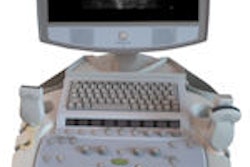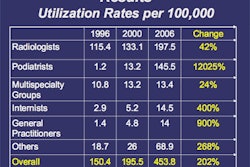NEW YORK CITY - Continued advances in technology, quality, and education will be necessary for ultrasound to secure its role in the future, according to Dr. Alfred Kurtz, professor of radiology and obstetrics/gynecology at Thomas Jefferson University (TJU) Medical College in Philadelphia.
Kurtz reflected on the past, present, and future of ultrasound during the William J. Fry Memorial Lecture on Friday at the 2009 annual convention of the American Institute of Ultrasound in Medicine (AIUM) in New York City.
In developed countries, the future of ultrasound will be characterized by competition with other imaging modalities such as CT, MRI, and PET, Kurtz said. For ultrasound to compete effectively for patients and reimbursement, it needs to produce more uniformity in diagnoses and recommended follow-up exams, faster scan time and increased throughput, and new and improved applications, he said.
Some problem diagnoses today include benign liver hemangiomas, benign gall bladder polyps, benign angiomyolipomas in the kidney, appropriate thyroid descriptions and biopsy recommendations, and differentiation of follicles and cysts in the ovaries, he said.
Some technology advances that could contribute to continuous image quality improvement include automatic image optimization, improved broadband technology, and better identification of microcalcifications, Kurtz said.
Volume-acquisition sonography also shows potential for increasing the speed of data acquisition and enabling offline image analysis. "[Offline image analysis] is the same way it's done on CT and MR," he said.
The technology has been proposed for use in gynecologic and obstetric applications, but it also shows potential value in small/superficial scanning applications such as musculoskeletal, thyroid, neonatal brain, and carotid artery scanning, he said.
Other technologies that can add to ultrasound's clinical value include miniaturization, computer-aided detection, ultrasound contrast agents (including new agents and clinical areas), therapeutic delivery systems, high-frequency ultrasound, and fusion imaging.
Developing countries
As for sonography's use in developing countries, the World Health Organization (WHO) has determined that ultrasound is a "sustainable technology," owing to its relatively low cost, portability, and durability. However, its availability has been limited by inadequate governmental infrastructure, a relative lack of trained professionals, and a lack of equipment, Kurtz said.
Education needs include initial education, such as formal training and e-learning over the Internet, as well as ongoing education such as follow-up training and access to Internet resources, he said.
To help with the task of ultrasound education, the Jefferson Ultrasound Research and Education Institute (JUREI) has been providing its Teach the Teachers program. This initiative aims to teach physicians from developing countries and provide needed materials and equipment.
Trained physicians then return to their native countries to establish teaching centers and train other physicians. To date, 72 JUREI-affiliated education centers have opened in more than 50 countries.
Kurtz also cited the role of the Global Ultrasound Equipment Donation Foundation (GUEDF), a nonprofit organization that has donated more than 300 ultrasound scanners to date for healthcare centers in developing countries. Vendors donating systems include GE Healthcare of Chalfont St. Giles, U.K.; Philips Healthcare of Andover, MA; and Siemens Healthcare of Malvern, PA.
Progress is also being made on the Internet-based learning front. Ultrasound e-learning modules for the U.K. have been developed by Dr. Paul Dubbins at Nuffield Hospital Plymouth under the Radiology Integrated Training Initiative (R-ITI), a collaboration between the Royal College of Radiologists and the National Health Service.
A global ultrasound curriculum is also in the works, headed by the World Federation for Ultrasound in Medicine and Biology (WFUMB) Education Committee, chaired by TJU's Dr. Barry Goldberg, and many other organizations are cooperating in the initiative, Kurtz said. The first phase of the program will establish a basic curriculum, with more advanced content to come later.
For a Web site to be optimal for ultrasound education, it needs to be easily accessed, cost-effective, and provide access to a broad spectrum of educational material, Kurtz said. This could range from basic to advanced material and utilize methods such as streaming videos, he said.
It should also have extensive cross links to ultrasound societies, as well as educational and commercial Web sites, Kurtz said.
By Erik L. Ridley
AuntMinnie.com staff writer
April 4, 2009
Related Reading
Radiology faces declining share of musculoskeletal ultrasound, January 20, 2009
Ultrasound can boost imaging use in developing countries, November 21, 2008
Ultrasound scan protocols for nonmedical personnel offer value, April 29, 2008
'Telemedicine' links Africans to Indian expertise, April 3, 2008
Handheld ultrasound performs well in ob/gyn applications, March 14, 2008
Copyright © 2009 AuntMinnie.com



















